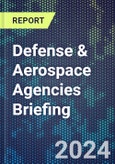The Defense & Aerospace Agencies Briefing is an information service that traces and analyzes the activities of nearly 40 US government agencies, facilities, and other contracting offices that annually dispense billions of aerospace and defense dollars to industry for RDT&E, Procurement, and Services. Defense & Aerospace Agencies Briefing reports are designed to help your company pursue its fair share of the market. The reports cover agency mission and capabilities, funding forecasts, program involvement, contract listings, and points of contact.
To be included in this service, an agency must be involved in either the research and development, procurement or service fields, and annually spend a major portion of its budget in the form of prime contract awards. Each agency has an individual report that is periodically updated to reflect the most recent activities. The reports are added to the service when new players emerge; conversely, an agency's report is removed when it drops out of the market or considerably lessens its involvement in the segment.
Also included are appendixes that give summary information on prime contract awards, including a directory of program managers and other key government contacts, an outline of company involvement by Program Elements and a listing of the past year's major prime contracting activity.
Table of Contents
Samples

LOADING...
Companies Mentioned
- Defense Advanced Research Projects Agency (DARPA)
- Defense Information Systems Agency (DISA)
- Defense Logistics Agency (DLA)
- Defense Threat Reduction Agency (DTRA)
- Department of Homeland Security (DHS)
- Federal Aviation Administration (FAA)
- Federal Bureau of Investigation (FBI)
- Maritime Administration (MARAD)
- Missile Defense Agency (MDA)
- National Aeronautics & Space Administration (NASA)
- National Geospatial-Intelligence Agency (NGA)
- National Oceanic & Atmospheric Administration (NOAA)
- United States Space Force (USSF)
- US Coast Guard (USCG)
- US Department of Energy (DoE)
- US Special Operations Command (USSOCOM)
- USA Aviation & Missile Command (AMCOM)
- USA Communications-Electronics Command (CECOM)
- USA Future Command (AFC)
- USA Joint Munitions Command (JMC)
- USA Materiel Command (AMC)
- USA Medical Research & Materiel Command (MRMC)
- USA PEO Simulation, Training & Instrumentation (PEO STRI)
- USA Research Laboratory (ARL)
- USA Research Office (ARO)
- USA Space & Missile Defense Command (SMDC)
- USA TACOM Life-Cycle Management Command (LCMC)
- USA Test & Evaluation Command (ATEC)
- USA Training & Doctrine Command (TRADOC)
- USAF Materiel Command (AFMC)
- USAF Office of Scientific Research (OSR)
- USAF Research Laboratory (AFRL)
- USAF Sustainment Center (AFSC)
- USAF Test Center (AFTC)
- USMC Systems Command (MARCORSYSCOM)
- USN Air Systems Command (NAVAIR)
- USN Air Warfare Center-Aircraft Div. (NAWC-AD)
- USN Air Warfare Center-Training Sys. Div. (NAWC-TSD)
- USN Air Warfare Center-Weapons Div. (NAWC-WD)
- USN Information Warfare Systems Command (NAVWAR)
- USN Office of Naval Research (ONR)
- USN Research Laboratory (NRL)
- USN Sea Systems Command (NAVSEA)
- USN Surface Warfare Center (NSWC)
- USN Undersea Warfare Center (NUWC)
Methodology
The publisher's analysts employ a combination of empirical and expert centered approaches to forecasting across multiple global defense and aerospace markets. Numerous variables play into future market requirements: macroeconomics, geopolitics, regional competitiveness, public and private market forces, cost pressures, country‐specific budget constraints, supplier relationships, etc.
We maintain proprietary databases that provide a strong foundation for building a quantitative understanding of key relationships between the forces that drive the demand for an array of products, platforms, and systems. These data assets have been developed and expanded over 30 years of company operations and provide an unapparelled set of resources that make the publisher uniquely qualified to forecast future industry performance. These empirical fundamentals allow for rigorous modelling.
In addition to this highly structured, data-driven perspective, the publisher through the expertise of its analysts has a comprehensive qualitative understanding of the forces that shape market demand. It is our position that forecasting demands both empirical understanding and artistic interpretation based on insights gained from decades of dedicated research and analysis. The result is a forecast that combines both to achieve a highly informed window to the future.

LOADING...








